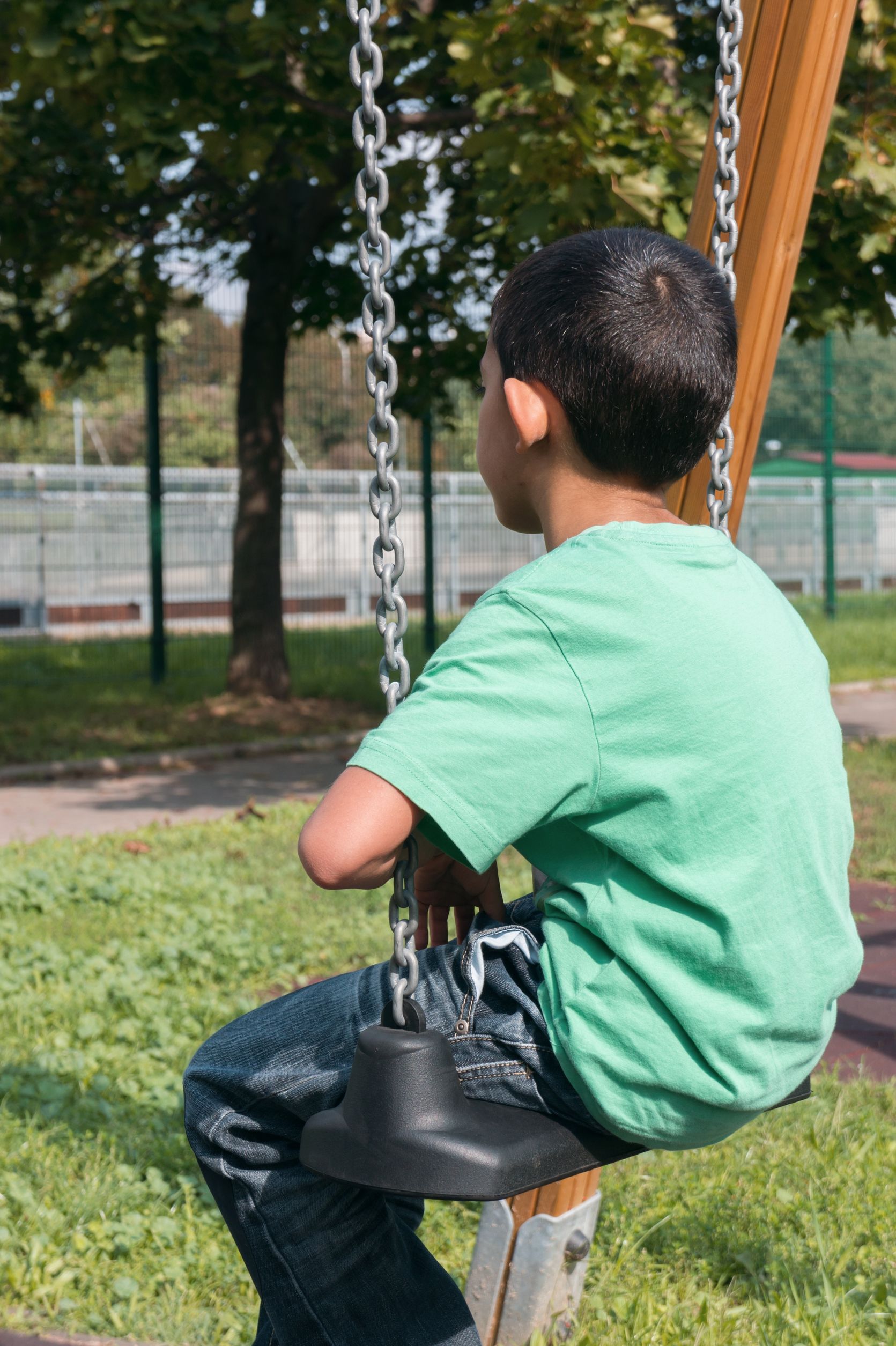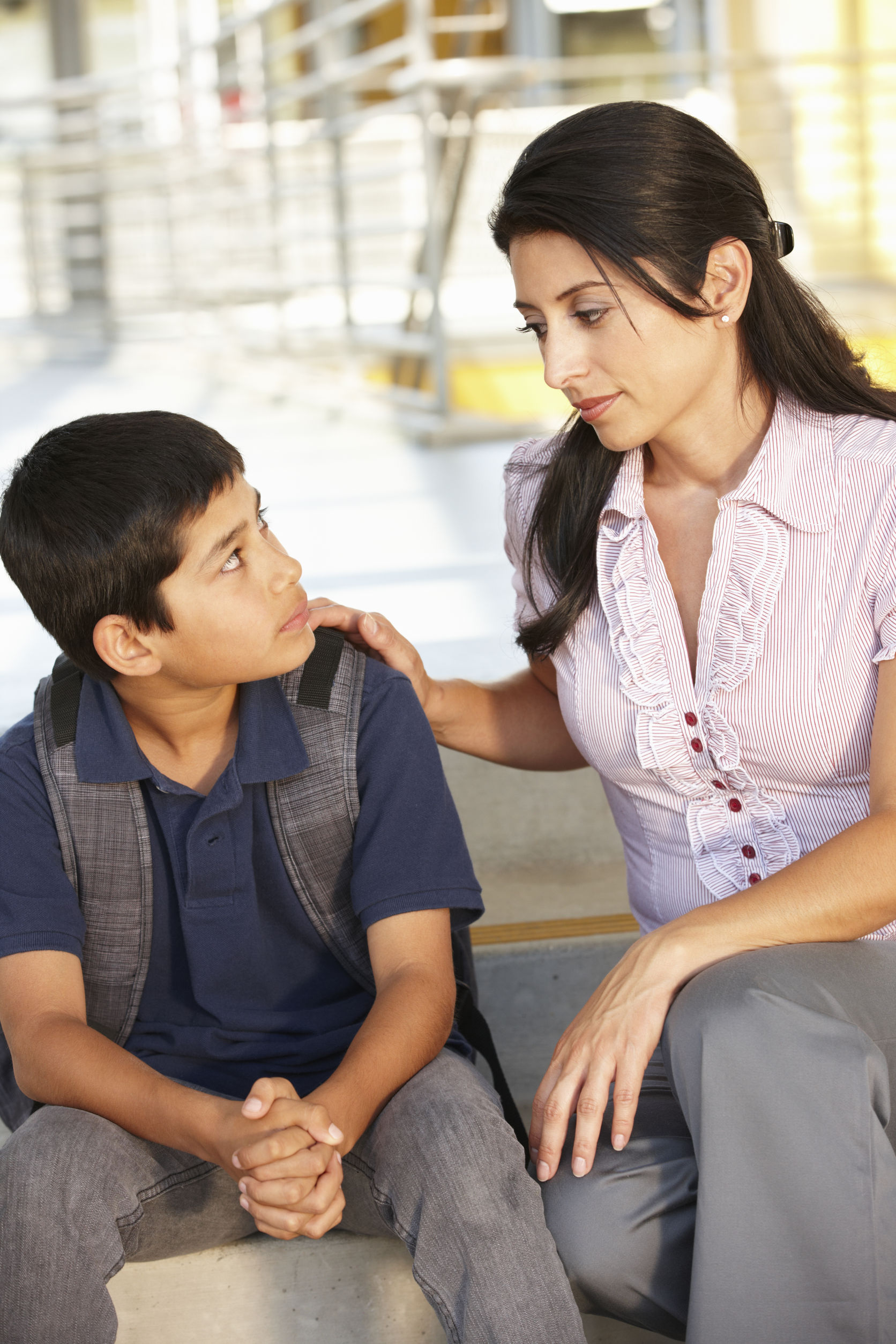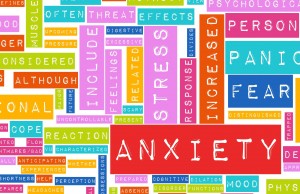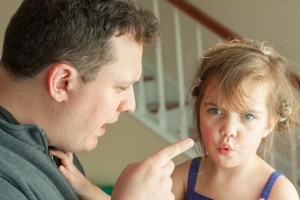 Does your child say, “I’m okay” to you even though you know they really are not? How can you determine if your child is experiencing a normal amount of sadness about a specific situation or clinical depression that warrants therapy with a child psychologist? While this treatable mental illness can run in families, others have no family history of depression at all. Often times, children and teenagers begin to show some depressive symptoms and if they seek help early they can get the support they need to live fulfilling lives.
Does your child say, “I’m okay” to you even though you know they really are not? How can you determine if your child is experiencing a normal amount of sadness about a specific situation or clinical depression that warrants therapy with a child psychologist? While this treatable mental illness can run in families, others have no family history of depression at all. Often times, children and teenagers begin to show some depressive symptoms and if they seek help early they can get the support they need to live fulfilling lives.
Top 10 Signs of Depression in Children and Teens:
- Irritability or Anger
- Sadness or Hopelessness
- Changes in Sleep
- Changes in Appetite
- Social Withdrawal
- Increased Sensitivity to Rejection
- Difficulty Concentrating or Low Energy
- Outbursts or Spontaneous Crying
- Making Negative Comments about Themselves
- Loss of interest or pleasure in hobbies and activities
When Is It Important to Seek Help?
While it is normal for children and teens to have sadness based on life events such as a family member, friend or pet dying, if a child or teen exhibits several of the symptoms listed above for an extended period of time, it may be important to seek professional support. If a child or teenager has had a personal or family history of depression, are currently undergoing major life changes (i.e. stress or trauma) and/or physical illnesses, these are increased risk factors for clinical depression. Common treatments for depression in children and teens are a combination of Cognitive Behavioral Therapy, Family Therapy, psychoeducation and medication. One person diagnosed with depression is not affected the same way as another person. Therefore, there is not a “one-size fits all” treatment. It is important to talk to your therapist about an individualized treatment approach.
Resources:
https://www.nimh.nih.gov/health/topics/depression/index.shtml
http://www.dbsalliance.org/site/PageServer?pagename=education_depression

According to Christopher McDougle, MD, director of Massachusetts General Hospital’s Lurie Center for Autism and a member of Autism Speaks Autism Treatment Network, “Mood disorders – including depression – do appear to be more common in those with developmental disabilities than in the general population.” It can be very difficult to identify depression in an individual with an autism spectrum disorder (ASD) though due to their general difficulty in expressing emotion verbally or through facial expressions. For this reason, it is important to look at other indicators of depression such as a loss of energy or interest in those things that the individual used to find pleasurable, loss of motivation, changes in sleep and/or appetite, social withdrawal, and a reduced desire to communicate with others. Still though, many of these symptoms can also stem from ASD rather than depression and therefore it can be difficult to tease apart. For these reasons, depression amongst those with ASD can often go untreated.
Depression in those with ASD most often emerges during late adolescence or in an individual’s 20s. It can be common amongst those with ASD due to its association with a range of difficulties across three areas, sometimes referred to as the triad of impairment – social communication, social understanding, and imagination. Deficits in these areas can lead to difficulties connecting with others and maintaining relationships, social withdrawal, being able to anticipate what will happen in given situations, and difficulties making plans for the future – all factors that can lead to feelings of depression. Additional factors include an individual becoming more aware of his or her diagnosis and disability, bullying, or a genetic predisposition to depression.
Identifying Depression
According to the Asperger’s Syndrome Foundation, there are three approaches that need to be made in diagnosing depression in a person with an autism spectrum disorder. They include the following:
-
-
- Observing any deterioration in cognition, language, behavior or activity due, as these may be indicators rather than verbal or nonverbal expression of depressed mood.
- Taking the patient’s history to establish their baseline, patterns of activity and interests. It is this pattern with which the presenting patterns can be compared.
- An attempt should be made to assess the patient’s mental state, both directly and through the caregiver, if present. Examples would include reports of crying, difficulties in separating from their caregiver, increased/ decreased activity, agitation or aggression. There may be evidence of new or increased self-injury or worsening autistic features, such as increased proportion of echolalia or the reappearance of hand flapping.
-
Strategies for Coping with Depression
According to autism-help.org, some personal strategies suggested by people with acquired brain injury might also be useful for an individual on the autism spectrum disorder. These strategies include:
-
-
- Having a nap
- Listening to music
- Watching television
- Working on a personal project
- Walking or other exercise
- Mental stimulation
- Scheduling activities and making short-term plans
- Self-Talk or thought challenging.
-
In mild to moderate forms of depression, psychological therapy may also be useful and in some cases the use of psychotropic medications may be necessary.
Suicide
According to Dr. McDougle, thoughts of suicide may also be common amongst those with ASD. For this reason, it is important for clinicians to assess for potential suicidal ideation whenever evaluating adolescents or adults with ASD.
References:
https://www.autismspeaks.org/blog/2013/05/13/whats-connection-between-autism-and-depression
https://autism-help.org/adults-aspergers-depression.htm
https://autism-help.org/aspergers-syndrome-adults.htm
 Worried about your child’s feelings around others? Here are some clues:
Worried about your child’s feelings around others? Here are some clues:
- Do they worry a lot about others thinking bad things about them?
- Do they often say no to social events or places where they’d have to talk to people?
- Are they not up for trying new things or going to new places?
If you said yes to these, your child might have something called Social Anxiety Disorder.
Recognizing Social Anxiety in Children
Knowing if a child has social anxiety means looking for some common signs:
- Fear of Social Situations: If they’re really scared about being around others or doing things in front of them.
- More than Just Shy: It’s not just being shy – social anxiety is bigger. It can make things hard in daily life. Shyness and social anxiety aren’t the same, even though they can be together.
- When It Shows Up: Social anxiety often comes around in the early teenage or preteen years. But it can start even when you’re younger.
- Struggling with People: They might be fine with family and close friends, but meeting new folks or talking in groups is super tough.
- Different Signs for Different Ages: Young kids might have tummy aches or not want to go to school. Older ones could have lots of negative thoughts, feel down, do poorly in school, or even turn to alcohol or drugs.
Remember, noticing these signs helps us understand and help better.
Recognizing Signs of Social Anxiety:
- Thinking Bad Thoughts: They might always think they’ll mess up or others won’t like them.
- Feeling Physical Stuff: Like stomach aches, blushing, sweating, shakiness, being extra upset, crying, or tense muscles.
- Feeling Nervous: They’re anxious or worried.
- Embarrassed or Ashamed: Feeling like they did something wrong.
- School Stuff: Not wanting to go, avoiding class, crying or tantrums.
- Staying Alone: Being by themselves a lot.
Diagnosis Checklist (based on the DSM-5):
- Scared in Social Scenes: Worried about being seen by others, like friends or adults.
- Fear of Messing Up: They’re scared they’ll do something wrong or show they’re anxious.
- Strong Reactions: Getting super scared in social situations, like crying, freezing, or not talking.
- Avoiding or Fearing: They stay away from these situations or face them with big fear.
- Too Much Fear: Feeling way more scared than they should.
- Six Months or More: This worry goes on for half a year or longer.
- Big Trouble: It makes life hard at school and with friends.
If your child shows these signs and struggles in their everyday life, It’s time to seek help. When your child has these feelings and it’s making their life harder, it’s okay to get help from an expert. Social anxiety disorder often gets better with Cognitive Behavioral Therapy (CBT). This type of help teaches kids how to handle their worries and change their bad thoughts. Being part of a group therapy can also be good. It helps kids face their fears, manage anxiety, and feel more comfortable around others.
Impact of School Refusal: How It Affects Kids:
When a child constantly avoids going to school, it can have significant effects on different aspects of their life. Firstly, it can cause problems with their schoolwork, making it harder for them to do well academically. Additionally, avoiding school can lead to difficulties in forming and maintaining friendships, which are important for social development. Moreover, this pattern can create challenges within the family, including conflicts with parents and missed work days. Behind all of this, there are also emotional struggles like anxiety and sadness that contribute to school refusal.
Furthermore, the longer a child stays away from school, the more challenging it becomes to return. This means that the longer they avoid school, the harder it can be for them to catch up on missed learning and reintegrate into the school routine. It’s essential to recognize that avoiding school doesn’t just affect one area of a child’s life; it has a ripple effect that touches their education, relationships, family dynamics, and emotional well-being.
Digging Deeper into School Refusal Causes
It’s important to know that school refusal isn’t just about a child skipping school for fun. Instead, it’s a situation where a child strongly doesn’t want to go to school at all.
Understanding School Refusal: Common Causes and Possible Reasons
Sometimes, there might be other reasons why a child doesn’t want to go to school. These could include:
- Bullying: If a child is being treated badly by others, they might not want to go to school.
- School Challenges: If they’re finding schoolwork tough, it could make them want to avoid going.
- Feeling Nervous: They might be worried about a test, a speech, or something else happening at school.
- Life Changes: Big events like moving, having a new sibling, or family changes can make school hard to handle.
- Emotional Struggles: Feelings like being too worried, sad, or not being able to handle social situations can lead to avoiding school.
- Physical Complaints: If they often say they’re sick, like having headaches or stomach aches, it might be a way to not go to school.
Remember, there could be more to the story when a child doesn’t want to go to school.
How can we help with school refusal?
When a child keeps avoiding school for a while, like days, weeks, or even months, there are ways to help them. This can include getting them back to school and helping with things like anxiety or similar.
We have plans to help with school refusal. The plans are different depending on how serious it is: mild, moderate, or serious. The cost and how long it takes are different for each person, but usually, the treatment goes on for about six weeks.
Step 1: Understanding Why a Child Doesn’t Want to Go to School
In this first step, we carefully examine why a child is avoiding school. A specialized therapist will be involved in this process.
- Thorough Discussion: The therapist will have a detailed conversation with the child and their parents. They might also talk to teachers, caregivers, and school staff.
- Gathering Information: We’ll collect important information. We’ll talk to the student and their parents, and possibly teachers or others involved. We’ll use tools like ratings and scales to help. We might also observe the child at school or home, either in person or through remote methods.
- Checking Health: Sometimes, we might need to get a doctor’s opinion to understand better.
This step is crucial to know what’s causing the child’s hesitation about going to school.
Step 2: Customized Advice and a Well-Planned Treatment
Treatment plans require consistent, dedicated planning and implementation to ensure the behavior is discontinued.
Treatment plans for students may include:
- Taking Small Steps: Students can get used to school by spending a bit of time there every day and gradually getting used to it.
- Learning to Relax: If a student feels nervous about school or talking to friends, they can learn ways to stay calm.
- Making Friends: Students can also learn how to be better at making friends and getting along with others.
- Earning Rewards: Going to school regularly can earn students cool rewards, which makes it more fun.
- Setting Goals: Students can decide on things they want to achieve at school and work towards them.
- Positive Thinking: When students worry, they can learn how to think in helpful and positive ways.
Parent/School training may include:
- Smoother Days: Making mornings and evenings easier by having a routine.
- Catching the Good: Giving attention when students do well and come to school. Making it not fun if they don’t come. Not paying attention to bad behavior.
- Time for School: Not letting the child do fun things like watch TV or play games when it’s time for school.
- Communication skills training: Learning how to talk so there’s less fighting at home.
Please contact us for more information or to schedule a consultation.
 With the increased number of terror attacks that we are hearing about in the news, something that had once been a much rarer occurrence may feel like it is happening at an increasing rate. As parents, this means that there may be more instances where our children will be exposed to such news. Events such as terrorist attacks can be quite frightening and difficult for adults to grapple with, which can make the question of how to speak to your children about it feel all the more daunting. There is no single answer and it may still be a difficult conversation, but here are some things to think about when you have one of these conversations with your children.
With the increased number of terror attacks that we are hearing about in the news, something that had once been a much rarer occurrence may feel like it is happening at an increasing rate. As parents, this means that there may be more instances where our children will be exposed to such news. Events such as terrorist attacks can be quite frightening and difficult for adults to grapple with, which can make the question of how to speak to your children about it feel all the more daunting. There is no single answer and it may still be a difficult conversation, but here are some things to think about when you have one of these conversations with your children.
- Prepare yourself. Think about what you want to say to your child, what message you want to convey to them in the conversation, and then think about how you can get that message across to your child. For younger children, the message should be one that acknowledges that something bad happened but also reassures them there are many people out there who are working very hard to keep us safe. For older children it may be ok to talk more about the issues underlying the incident or terrorism in general, while still offering the reassuring and realistic message about the many people around the world who are in charge of keeping us all safe.
- Start with your child. Open up the conversation by finding out what your child knows about the situation and asking what questions they have about it. This allows you to get a sense of what they already know and ensures that you will not give them more information than they can handle. For example, a child may want to know if everyone is ok or was taken to the hospital on time, and once you have answered that question, he may thank you and go off to play or finish homework.
- Use developmentally appropriate language and material. The words you use and the amount of information you share may be different for each of your children, depending on their age and developmental level both in regards to intellect and emotional maturity. Think about this and plan ahead before speaking to each child.
- Be honest.It’s ok for children to see their parents upset, sad or angry about things. Children know when parents are being disingenuous with them so if you are feeling sad or scared, it’s ok to let them know that. It is, in fact, an opportunity to model the skill of “talking about your feelings” with them and for them to see you cope with those feelings. Seeing you label your feelings and talking with your children about how you cope with those feelings is an important emotional lesson. At the same time, make sure that you are able to cope well enough in the moment so that you do not overwhelm your child with your own feelings. If you do not feel able to have the conversation, ask your partner or another close family member if they can talk to your child, and make sure that you get the help and support you need as well.
- It is ok to say “I don’t know”.You may feel the need to have all the answers but it is ok not to. What is important is that you are open and honest with your children and that, if it is an ongoing situation, that they know you will keep them updated as the situation unfolds. To be in a place of not knowing can be very uncomfortable for both adults and children, but it is also an important lesson in how to cope with so many of life’s questions or events when our best answer may be “I don’t know.”
- Keep the conversation going. Sometimes, when we talk to children about a topic where we have prepared all of the answers to their potential questions, they respond to us with silence. Know that it is ok and they may need some more time to take it all in and that they may come back to you in an hour, a day or a week, ready to continue the conversation. Let your children know you are there to talk when they are ready and that once the conversation has been opened up, they can come back to it with you as often as they need.
- Show them you love them. Remember that we all inhabit many different worlds and that the first and most intimate world is that of the family. Make that a place of love and safety by not only telling your children with words the messages you want to communicate with them-be it “I love you” or “you are safe here” or “I am here when you’re ready”-but show them as well by spending time together and being there for them when they need it.
While it is important to note that many children will have some kind of reaction and questions surrounding a terrorist attack, it is also important to know that children are quite resilient and most will be ok, even if they seem shaken up at first. If you have any concerns about your children – if you notice a change in sleeping or eating patterns, in overall mood or in behavior at school, at home or with friends – you can consult with a child psychologist to help your child who may be struggling to cope with these matters.

Distress Tolerance Skills In Dialectical Behavior Therapy (DBT)
 Families can encounter a variety of stressors – some of which do not tend to significantly affect their functioning, while there are others that do.
Families can encounter a variety of stressors – some of which do not tend to significantly affect their functioning, while there are others that do.
The latter type of stressors may include, but are not limited to:
- Parental stress and/or mental illness
- Separation/divorce
- Trauma – e.g., significant injuries, witnessing community violence, terrorism, life threatening events such as fires or car accidents, abuse, domestic violence
- Death of a loved one
- Parental job loss
- Moving homes
When these types of stressors occur, many children may start experiencing symptoms of anxiety, depression, and/or behavioral problems, which many parents may have difficulty managing due to the stress that they are also experiencing and subsequent depleted emotional and mental energy. The result then tends to be a very emotionally charged and conflictual situation in which the parent-child dynamic has shifted to a more negative interaction style, as the child’s behavior elicits negative parental reactions, which then, in turn, leads to increased behavioral difficulties. This can then lead to a family feeling as though they are spirally out of control, but it does not have to be this way.
In times like these, a specialized treatment program called Parent-Child Interaction Therapy (PCIT) is highly effective in getting things back on track. Due to its focus on increasing positive parent-child interactions, and consistency and predictability, it re-establishes what is often lost during times of stress.
What specifically is PCIT?
PCIT is a type of family treatment for children between the ages of 2 and 7 years old. It utilizes a live coaching model in order to optimize change in the parent-child dynamic, and focuses on developing a parent-child relationship in which the child feels safe and secure (a sense that is often lost in times of significant stress) through the use of positive attention and clear and consistent rules and limits.
What does the process look like?
- Treatment begins with an observation of the parent-child interaction in different situations in order to ensure that PCIT is the right fit.
- The following sessions then consist of two different types:
- Teach sessions during which your PCIT clinician teaches you the specific skills that you will be practicing and utilizing in your interactions with your child
- Coaching sessions during which your PCIT clinician will observe and coach you through a one way mirror in the use of the skills.
- Treatment consists of two different phases:
- Child Directed Interaction (CDI) – Focuses on establishing a more positive parent-child interaction through the use of positive attention and play therapy skills that create a strong connection and sense of safety between the parent and child.
- Parent Directed Interaction (PDI) – Parents learn how to set clear and consistent limits, which leads to a sense of predictability for both the parent and child.
How does my family begin?
The Manhattan Psychology Group has several certified PCIT clinicians who are eager to help your family begin working towards developing a more positive familial dynamic and decreasing family stress. So, if you feel as though your family is currently under a lot of stress and conflict and would like to work towards turning things around, simply call the number below to schedule an intake.
 An expected part of adolescence is developing and engaging in romantic relationships.
An expected part of adolescence is developing and engaging in romantic relationships.
An exciting and fun time yet stressful, too. Teens are navigating their different feelings, new situations and experiences for the first time. Unexpectedly abusive behaviors unfortunately are a part of the experience for some teenagers.
Assault/abuse can be in various forms; physical force/ harm, sexual, intimidation, humiliation (emotional) or verbal (threats, name calling). Violence does not discriminate on age, gender, race, or sexual orientation. According to the Centers for Disease Control and Prevention (CDC), a survey taken in 2013, conveyed that approximately 10 % of students in high school reported physical abuse and 10% reported a sexual assault from a partner in a twelve month period. Another statistic the CDC shares is that 1 in 4 adolescent’s report abuse (sexual, physical, emotional or verbal) by a partner each year.
Teen dating abuse can happen in person, via social media, cell phones, or text messages. Violence can occur in private or in public forums and impact teens functioning in many ways. Teaching our teenagers about assault and having an open dialogue with them is important. This conversation should not to be avoided or ignored. Starting the conversation before they become involved in a relationship is most ideal.
A parent can help a teenager stay safe, be well informed and know what to do if he or she may need help. A parent’s role is also vital before a relationship begins, during and once an assault has happened. The response an adult gives can set the stage for how a person handles their situation in regards to seeking or accepting help.
What does a parent educate their teen about?
- Consent vs Coercion:
- Coercion:feeling pressured to do something
- Consent: making an active choice to agree to do something
- Body Safety / How and when to say “NO”
- Healthy relationships
- Setting limits and having boundaries with partners
- Appropriate dating behaviors
- Reinforce no one deserves to be mistreated
- Give information about risky situations
- Substance use / parties / isolated settings
- Paying attention to instincts
- Safety plans
- When on a date or at a party
Information for parents to consider:
- Any teen can encounter sexual assault regardless of their gender or sexual orientation
- Perpetrators are frequently someone your teen will know
- Online safety and appropriate use of cell phones is critical
- Delayed disclosures are common
- Modeling healthy relationships is instrumental
What can you do after you learn an assault has occurred:
- Show concern and reassure them that they are not alone
- Seek medical attention, if needed
- Avoid blaming
- Listen, don’t judge.
- If a teen believes you will listen and not yell or punish they will be more willing to be honest and open.
- Create a safety plan if they will see the perpetrator again or remain involved with them
- Reassure him or her of your love and concern for them
- Utilize available help hotlines
- Obtain counseling services for your teen
Counseling:
A wide range of emotions commonly occur for the person assaulted and their loved ones after an incident and disclosure. A teen having a safe and therapeutic setting to discuss their strong emotional pain, thoughts and experiences is important to help a teenager move forward. A psychologist is able to guide and support a teenager and their family to decrease their level of distress that may be occurring as a result of an assault.
Resources:
If at any time you feel that you or your teen is in immediate danger, call 911.
Love is Respect
866-331-9474 www.loveisrespect.org
New York State Domestic and Sexual Violence Hotlines
- Outside New York City: 1-800-942-6906
- In NYC: 1-800-621-HOPE(4673) or dial 311
National Domestic Violence Hotline
800-799-SAFE (7233) www.ndvh.org
Rape, Abuse & Incest National Network (RAINN) Hotline
800-656-HOPE (4673) www.rainn.org
Resources used for this blog:
*Vagi, K. J., Olsen, E. O., Basile, K. C., & Vivolo-Kantor, A. M. (2015). Teen dating violence (physical and sexual) among US high school students: Findings from the 2013 National Youth Risk Behavior Survey. JAMA Pediatrics, 169, 474-482.
https://www.cdc.gov/violenceprevention/intimatepartnerviolence/teen_dating_violence.html
National Center for Victims of Crime http://www.ncvc.org/
http://www.apa.org/pi/families/resources/love-teens.pdf
 Constant worrying. Imagining the worst case scenario. Difficulties concentrating. Mental fatigue. Restlessness. Sound familiar? If so, you might be experiencing symptoms of anxiety, which in many cases can be quite debilitating. Fortunately, effective treatment is available through the use of Cognitive Behavioral Therapy (CBT).
Constant worrying. Imagining the worst case scenario. Difficulties concentrating. Mental fatigue. Restlessness. Sound familiar? If so, you might be experiencing symptoms of anxiety, which in many cases can be quite debilitating. Fortunately, effective treatment is available through the use of Cognitive Behavioral Therapy (CBT).
What does CBT entail?
General components of CBT for anxiety include the following:
- Psychoeducation – Learning more about your anxiety through identifying the connection between bodily sensations that indicate the presence of anxiety, anxiety provoking thoughts, and actions (e.g., fleeing the situation).
- Developing Relaxation Techniques – e.g., progressive muscle relaxation, deep breathing, imaginal relaxation.
- Cognitive Reframing – Anxiety is often the result of automatic thoughts that an individual has regarding certain situations. For example, in the case of social anxiety, when going to a party, one may have thoughts such as “No one will like me” or “I’m going to embarrass myself.” Since our thoughts determine our feelings about a situation, identifying, challenging, and reframing these thoughts is an effective way of changing your emotional reaction to a situation, as it is our thoughts that determine our feelings. Through reframing these thoughts, instead of experiencing anxiety in a certain situation, you instead will be able to have positive feelings about it such as happiness or excitement.
- Exposure – The most effective way to overcome anxiety is to actually face your fears. Although this may sound very scary at first, this approach is actually quite gradual in nature starting with having you face more benign situations that only result in a mild state of anxiety to gradually building up to facing those situations that cause you to experience intense anxiety and make you want to flee. Through facing your fears instead of fleeing from them, you will learn to tolerate the distress that they cause ultimately leading to your overcoming them.
Does CBT for adults look different than CBT for children?
Although the aforementioned components of CBT are consistent for both adults and children, the approach taken with children might be slightly different in order to better engage them. For example, fun worksheets, games, storytelling, and play may be used in order to help children learn about anxiety, develop relaxation skills, and reframe those negative cognitions that result in anxiety. Specific books and treatment approaches that have kid friendly activities such as The Coping Cat Workbook might also be utilized. In addition to these methods, parental involvement is also a key component in helping a child overcome their anxiety.
What is a parent’s role in anxiety treatment for children?
- Recognizing your own fear and modeling how to stay calm – Children learn a lot about how they should react to certain situations and deal with anxiety from their parents. For this reason, it is important for a parent to be able to model staying calm in the face of anxiety, and also go one step further by encouraging their child to be brave and face their own anxiety provoking situations.
- Providing positive attention for your child’s brave behaviors – This can take the form of verbal praise or tangible rewards for tolerating and getting through scary situations.
- Not allowing your child to escape anxiety provoking situations – When your child escapes a scary situation, their fear is only reinforced making their anxiety regarding the situation increase even more. Even though it might be tempting to allow your child to avoid or escape these situations, if you are wanting to support your child in overcoming their fears you must not allow them to escape anxiety provoking situations. By encouraging and supporting them instead, they will learn to tolerate the distress that these situations cause and ultimately overcome it.
Who do I go to for CBT for anxiety?
Mental health professionals such as psychologists, licensed clinical social workers, and psychiatrists who have specialized training in CBT for anxiety have the necessary tools to help you or your child overcome anxiety. If you are tired of having anxiety interfere with you or your child’s every day functioning it may be time to seek support in overcoming it. With a little bit of motivation and the right support, you or your child will be able to learn how to effectively manage anxiety and live a healthier lifestyle.
Post-traumatic Stress Disorder (PTSD) is a psychiatric condition that impacts adults and children. PTSD is experienced by some people after they are faced with a traumatic experience. Symptoms of trauma are experienced in many ways; physically, emotionally, cognitively, and behaviorally. The symptoms can affect day to day functioning as well as relationships with others.
The American Psychological Association (APA) describes PTSD for many as reliving the traumatic event through memories that are intrusive, having nightmares or flashbacks. Additionally, people may avoid trauma reminders and experience anxiety which is often debilitating. For individuals that are parents and have symptoms of PTSD there can be direct influences on children.
Parenting is a challenging endeavor. Add stress associated with a traumatic experience and the key features of nightmares, flashbacks, increase arousal, anxiety in addition to anger and sadness, it is no surprise family members would struggle, too. Children are like sponges that pay attention to their parents and rely on them. The United States Department of Veteran Affairs has recognized the impact of PTSD on children. They have focused on veteran’s PTSD symptoms and the influences it has on family, spouses and children. Although the VA focuses on veterans, even if a parent has not experienced war, other traumas can affect the family just the same.
Five ways PTSD in parents may affect children
- Emotionally. Children may be exposed to strong emotional reactions and behaviors that a parent displays. This can lead to a child feeling frightened or confused. A child may also begin to worry about their parent and experience sadness. Furthermore, watching a parent struggling to cope can impact a child’s ability to express their emotions appropriately.
- Developmentally. A parent is a role model and a teacher. In addition to a parent modeling inappropriate ways to cope the may have trouble problem solving. They may feel emotionally numb, unavailable and detach from their family members and children. Therefore, bonding and attachment to a child may be difficult for a parent. This can interfere with a child’s development. Additionally, a parent that avoids situations or people due to their high level of distress can lead to a child missing out on experiences and opportunities.
- Behaviorally. Children may try to step in to protect their parent and take on a role or responsibility that is not meant for them. Children’s emotional distress may affect their behaviors in school and academic performance. Their anger and confusion may be the underlying cause to disruptive behaviors observed in school or at home.
- Interpersonally. Limited emotional support and inconsistent relationships with parents can impact future relationships for children. These patterns can go into adolescence and adulthood.
- Cognitively. Parenting is stressful even without a trauma history. Parents are at higher risk for irritability and poor sleep patterns due to trauma symptoms. This results in parenting behaviors that may become harsher or less involved. Parents may respond quickly to children’s misbehaviors, withdraw from them or coddle. Children may think that their parent does not want to do things with them, does not love them or may get the wrong idea and not understand what is truly happening.
What can a parent do?
- Help a child understand it is not their fault and they are not to blame.
- Education about PTSD is very important. Two recommendations are:
- Book for ages 4-8:Why Are You So Scared? A Child’s Book About Parents with PTSD by Beth Andrews, LCSW
- Book for teenagers: Finding My Way: A Teen’s Guide to Living with a Parent Who Has Experienced Trauma by Michelle D. Sherman, PHD and Deanne M. Sherman
- Seek individual therapy for yourself
- Consider individual therapy for the child. A therapist can assist the child with learning how to cope and to help understand their parents struggle. A therapist can also help a parent explain to a child what is occurring in a child friendly and age appropriate manner.
- Use resources that are available:
Resources:
Cohen, J.A., Mannarino, A.P., Deblinger, E. (2006). Treating Trauma and Traumatic Grief in Children and Adolescents. New York: The Gilford Press.
 Time out is a highly effective evidence-based discipline procedure that can significantly reduce behavioral problems in children. Decades of research has shown that when used appropriately, time-out is a safe and very useful tool for managing misbehavior in young or school-aged children. In order for time-out to work, it is important that specific steps are followed and that parents remain consistent in their use of time-out.
Time out is a highly effective evidence-based discipline procedure that can significantly reduce behavioral problems in children. Decades of research has shown that when used appropriately, time-out is a safe and very useful tool for managing misbehavior in young or school-aged children. In order for time-out to work, it is important that specific steps are followed and that parents remain consistent in their use of time-out.
Unfortunately, all too often parents and caregivers attempt to use time-out without understanding clearly all the steps required for effective time-out or without consistency, which leads to poor discipline at home and frustration for parents. Below is a “how-to” primer for implementing time-out in your home.
When to use Time Out: Prior to using time-out, it is important to decide when and how you will implement time-out in your home and explain this to your child. Time out should be used for aggressive behaviors (hitting, screaming, kicking) or non-compliance with specific commands (for example, when a child refuses to brush her teeth).
Steps for Using Time Out:
- If you child does something aggressive, tell your child why they are being put in time out (“You hit Johnny, so now you need to sit in the time out chair”). Make sure to say this calmly and to not say anything else. You do not want to give your child a lot of attention when they misbehave because that can lead them to misbehave more in the future.
- If your child is not complying with something you have asked them to do wait 5 seconds and then give your child a warning “If you don’t ____________, you will have to sit in the time out chair.” Wait another 5 seconds (without saying anything else) and if your child continues to not comply say “You did not do what I told you to do so now you have to sit in the time-out chair.”
- Immediately take your child to the time out chair and walk away (again we want to give the child as little attention as possible when they are in time out).
- It’s best to use an adult sized chair for time out. Make sure the chair is safe and sturdy. Do not use a chair that can spin or has wheels. The chair should be placed facing a wall (but far enough away from the wall that the child cannot damage the wall with her shoes) and away from any activity in the house (e.g., away from the TV). The child should not be able to bring any items with her to time out.
- If your child stays in the chair, she should remain there for 3 minutes. This is enough time for time-out to be effective. During this time your child should not receive any attention (facial expressions and eye contact count!).
- If your child gets up from the chair, immediately place her back in the chair and tell her she needs to stay in time out until you say she can get up. For many children this warning will work. Other times, it may be helpful to use a back up to time-out to help teach the child to stay in the chair. You can either use a back-up time out room (a safe room in the house with no toys to put the child in alone for 1 minute if she leaves the chair) or the removal of a privilege for getting out of the chair (e.g., “If you do not stay on the time out chair, you will lose screen time for the remainder of the day”). If you are using a back-up room take the child back to the time out chair after 1 minute in the time out room.
- If you child is in time out for aggression, then after 3 minutes of sitting in the chair quietly, say “You are sitting quietly in the time-out chair, are you ready to get up?” If your child gestures or says “yes” allow her to get up from the chair. If your child indicates “No” then restart time out for another 3 minutes.
- If your child is in time out for noncompliance then after 3 minutes say “Are you ready to insert previous command [e.g., brush your teeth?].” If your child indicates “yes” allow them the opportunity to complete the instruction; however, if they indicate “no” then restart time-out.
- Following time-out it is important to provide your child with praise for positive behavior. If your child was in time out for aggression, try to catch your child as soon as possible engaging in a positive behavior and give your child attention for this behavior. If your child is in time out for noncompliance, praise your child as soon as they complete your instruction (e.g., “Thank you so much for brushing your teeth”). This is one of the most important steps in time out and helps your child learn that they do not get attention if they misbehave, but that they get a lot of positive attention when they listen and behave appropriately.
- Learning how to use time out appropriately can be difficult for many caregivers. It is often very helpful to learn time out from a mental health professional who is trained in teaching time out and who can help you practice the steps with your child in session prior to trying time out at home.
The following sources were used in preparation of this article: Eyberg, S., & Funderburk, B. (2011). Parent – Child Interaction Therapy Protocol. Gainesville, FL: PCIT International Publishing.




